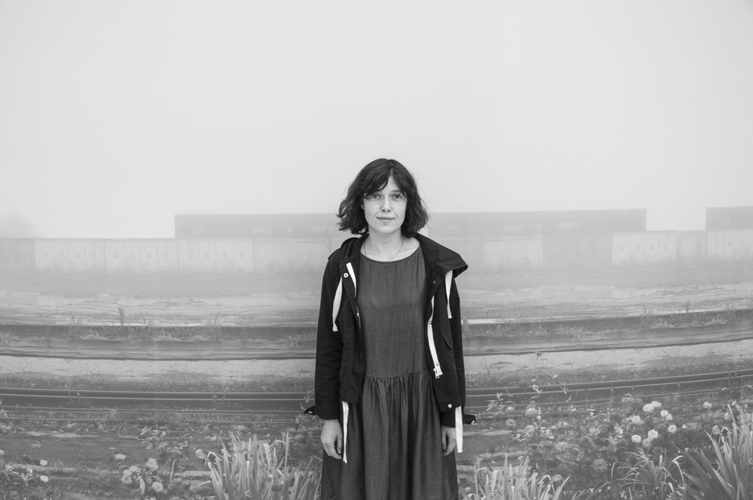

– Ukrainian photographer, writer, and translator, born in Kyiv in 1980. Co-founder of the literary-artistic-political journal “Prostory,” member of the interdisciplinary curatorial group “Hudrada,” author of the photo series Victories of the Defeated, and the photo-illustrated books Lucky Breaks (recipient of the International Literature Award—Haus der Kulturen der Welt in 2020) and Series of Lectures on the Modern Life of Animals. Her work meets at the intersection of visual art, literature, journalism, and social activism, between document and artistic language. She lives and works in Kyiv and Berlin.
Agenda
When I was offered the opportunity to write an article for the Ukrainian Dictionary of Contemporary Art, more than anything I wanted to write the entry “An Agreement on Personal Failure” a mental contract permitting me to distance myself from the dogmatic constructions of artistic work1.
“An Agreement on Personal Failure
An oral, written, mental agreement that the artist enters with herself so that various forms of defeat accompany her work and through these “failures” the work is protected, or the artist is protected from incorporation into the “successful” and from absorption by sociological and ideological practices and narratives2.
Additionally: this kind of agreement concentrates in oneself senseless torments, unattainable goals, unrealizable projects and projects created in order to never be fulfilled, inconclusive treatises, manifestos made so radically out of touch with the ability to practice that they hang in the air like an axe above the head of a sleeping person, series of works that the artist consistently withholds from representation, embarrassed in her surprise that no one else is exhibiting them.
This same agreement manifests in various personal and professional tactics, making the artist awkward, unagreeable, dangerous, boring, unfashionable, unpredictable, predictable, etc.—depending on the demands of time and situation (…)”3
Failure—the sphere of justification of unrealized hopes. An illusive mist.
What if the conversation about failure is too neatly formed?
Does it mean that it loses itself, loses its own foundations, is nullified? Or despite all the circumstances, it continues to live—in artistic work, in stumbles, in the damp tracks that it leaves on the ground like wet feet.
To elevate failure as a principle, to rely on it, so as to sit afterward and with naïve joy/comical fright/silly seriousness and watch how its remains smolder on the bonfires of various “achievements.” And at the same time, one can rely on failure! (I exclaim even more naïvely)4
Even when it is hollowed out, failure is still right there.
Photography—when it searches for the historical, searches for an activist program of art it is a huge failure. Such photography needs someone else to use its raw material, a pitiful document for a true work of art.
And I expect, wish, insist on a halfway stopping point, there, where the work has not yet arisen, but has only started taking shape.
In search of the absurd, I often collide with the documentary, with the aspiration of photography to speak out and even call for justice. As if in the muteness and immobility of the photographic image could be concentrated in complaints, claims, reproaches, quiet voices.
Now there’s nothing to be heard.
And I wanted, avoiding history, to talk about the present moment. Cross out history. Or to subject it, like a trap of reflections, to some kind of disaster so that it, with its catastrophe, would stop stepping on the heels of all that I see. But photography does not stand “outside of history.” It obsessively accumulates moments and places, events5.
My documentary projects did not collect episodes, more sought out the mysterious contents of situations to which I arrived with a camera. But one had only to hope that the “situation” conveyed its clear aspirations to reality, that I found a fulcrum in the narrative as it turned into a shell, a form, a stream of words, wild bursts of laughter.
Something similar happened with my project Victories of the Defeated—consisting of texts and a series of photographs taken in the mines in the warzone of eastern Ukraine, and then Lucky Breaks—a book refuting the basis of my photographic work.
It was as if I was searching for something forgotten in the space around me, something beloved and abandoned. Every time, when society invents itself anew, it is forced to give up something. The very gesture of turning forward, to the future, turns a part of reality into “the past.” If the past interests me, then it is precisely this “new past,” “the past” that arises as a name which is given to a part of reality. The branded mark that photography is in love with6.
In this sense, I was very lucky to work in Ukraine.
Concluding “An Agreement on Personal Failure,” I constantly forget about exactly which kind of failure was meant. Therefore, it’s difficult to say to what extent this agreement has already been broken and with what kind of naïve faith, with what kind of comical zeal.
This text was prepared for Kateryna Iakovlenko, curator.
1Image: Yevgenia Belorusets, From the project Gogol Street, 32. Courtesy of the artist.2Image: Yevgenia Belorusets, From the project Gogol Street, 32. Courtesy of the artist.
3Image: Yevgenia Belorusets, From the project Me and She. Courtesy of the artist.
4Image: Yevgenia Belorusets, From the project My room. Courtesy of the artist.
5Image: Yevgenia Belorusets, From the project Victory of the Lost. Courtesy of the artist.
6Image: Yevgenia Belorusets, From the project War in the Park. Courtesy of the artist.
– народилась у 1980 році і Києві – українська фотографка та письменниця, перекладачка. Співзасновниця літературно-мистецтво-політичного журналу «Простори», учасниця міждисциплінарної кураторської групи «Худрада», авторка серії робіт «Перемоги переможених», книжок «Щасливі падіння» (відзначено Міжнародною літературною премією Haus der Kulturen der Welt у 2020 році) та «Цикл лекцій про сучасне життя тварин». Її роботи рухаються на стику мистецтва, літератури, журналістики та громадської активності, між документом і художньою мовою. Живе та працює у Києві та Берліні.
Програма дій
Коли мені запропонували написати статтю для українського Словника сучасного мистецтва, понад усе мені хотілось описати «Договір про власну невдачу» — мисленнєвий контракт, що дозволяє дистанціюватися від догматичної складової праці художника.
«Договір про власну невдачу»
Усний, письмовий, мисленнєвий договір, що його художник або художниця укладає зі самим собою для того, щоб різні форми поразки супроводжували його або її роботу і через «невдачі» захищали твір або саму художницю від включення в «успішні» і поглинаючі соціальні й ідеологічні практики і наративи.
Також: такого типу договір містить беззмістовні муки, недосяжні цілі, неможливі для втілення проєкти, і проєкти, створені для того, щоб ніколи не бути втіленими, незавершені трактати, маніфести, які творяться настільки радикально відірваними від можливості практики, що вони зависають в повітрі, як сокира над головою сплячого, серії робіт, які художник послідовно притримує і не репрезентує, ніяково дивуючись що їх ніхто не виставляє.
Цей же договір діє через різні особисті і професійні тактики, роблячи художника незручним, недоговороздатним, небезпечним, нудним, немодним, непередбачуваним, передбачуваним і т. д. — залежно від вимог часу і ситуації (…)»
Невдача — сфера виправдовування невиправданих надій. Зникаюча туманність.
А що як розмова про неї занадто зграбно складається?
Отже — вона втрачає себе, втрачає власні основи, обнуляється? Або, напротивагу всім обставинам, продовжує жити — у творі, спотиканні, у важливих слідах, які вона залишає на землі, подібно до мокрих ніг.
Виокремити невдачу як принцип, опертися на неї, щоб потім сидіти і з наївною радістю/комічним страхом/дурнуватою серйозністю спостерігати як тліють на вогнищі різних «досягнень» її рештки. І все ж, на неї можна покластись! (ще наївніше вигукую я).
Навіть вичерпавшись вона поряд.
Фотографія — у пошуках історичного, в пошуках активістської1234 програми мистецтва, це величезний провал. Вона ніби потребує, щоб хтось інший використовував її сирий матеріал, жалюгідну документальність для істинного твору.
А я вимагаю, прагну, наполягаю на зупинці на півшляху, там, де твір ще навіть не виник, а лише зароджується.
В пошуках абсурдного я часто зіштовхуюсь з документальним, з прагненням фотографії висловитись і навіть закликати до справедливості5. Так, ніби в німоті і непорушності фотографічного зображення могли зосереджуватися скарги, претензії, докори, тихі голоси.
Тепер вже нічого не чути6.
А мені хотілось, уникаючи історії, говорити про теперішній момент. Викреслити історію. Або підпорядкувати її, як мережу віддзеркалень, якомусь лиху, щоб вона зі своєю катастрофічністю перестала наступати на п’яти тому, що я бачу. Але фотографія не витримує позаісторичності. Вона нав’язливо накопичує моменти і місця, події.
Мої документальні проєкти не колекціонували епізоди, а радше шукали таємні сенси ситуацій, до яких я приходила з фотокамерою. Але, щойно в мене виникала надія, що «ситуація» висловила свої чіткі вимоги до реальності, що я знайшла точку опори в оповіді, вона одразу перетворювалась в оболонку, форму, потік слів, дикі вибухи сміху.
Щось подібне сталося з моїм проєктом «Переможи переможених», що складається із серії фотографій, створених у шахтах в зоні бойових дій на сході України, текстів, потім книги «Щасливі падіння», яка заперечує основи моєї роботи з фотографією.
Я наче шукала щось забуте в навколишньому просторі, улюблене і покинуте. Кожного разу коли суспільство заново себе винаходить, воно змушене від чогось відмовитись. Сам жест повороту вперед, до майбутнього, перетворює частину дійсності в «минуле». Якщо минуле й цікавить мене, то саме те, «нове минуле», «минуле», що виникає як ім’я, яким називають частину дійсності. Клеймо, в яке закохана фотографія.
В цьому сенсі мені дуже пощастило працювати саме в Україні.
Укладаючи «Договір про власну невдачу», я постійно забуваю про те, яка саме невдача малась на увазі. Тому складно сказати наскільки цей договір вже порушено і з якою наївною вірою, з якою комічною старанністю.
Текст написано у співпраці з кураторкою Катериною Яковленко (2022).
1Зображення: Євгенія Белоресуць, З проєкту “Гоголівська вулиця, 32”. Надано художницею.2Зображення: Євгенія Белоресуць, З проєкту “Гоголівська вулиця, 32”. Надано художницею.
3Зображення: Євгенія Белоресуць, З проєкту “Я та Вона”. Надано художницею.
4Зображення: Євгенія Белоресуць, З проєкту “Своя кімната”. Надано художницею.
5Зображення: Євгенія Белоресуць, З проєкту “Перемоги переможених”. Надано художницею.
6Зображення: Євгенія Белоресуць, З проєкту “Війна у парку”. Надано художницею.